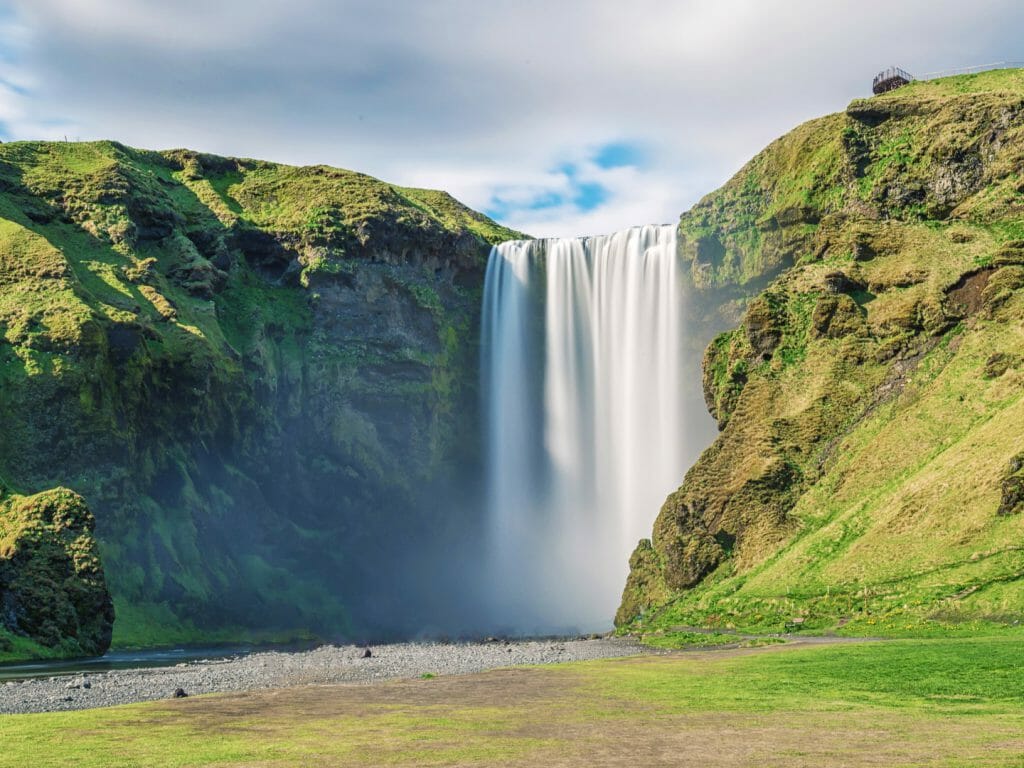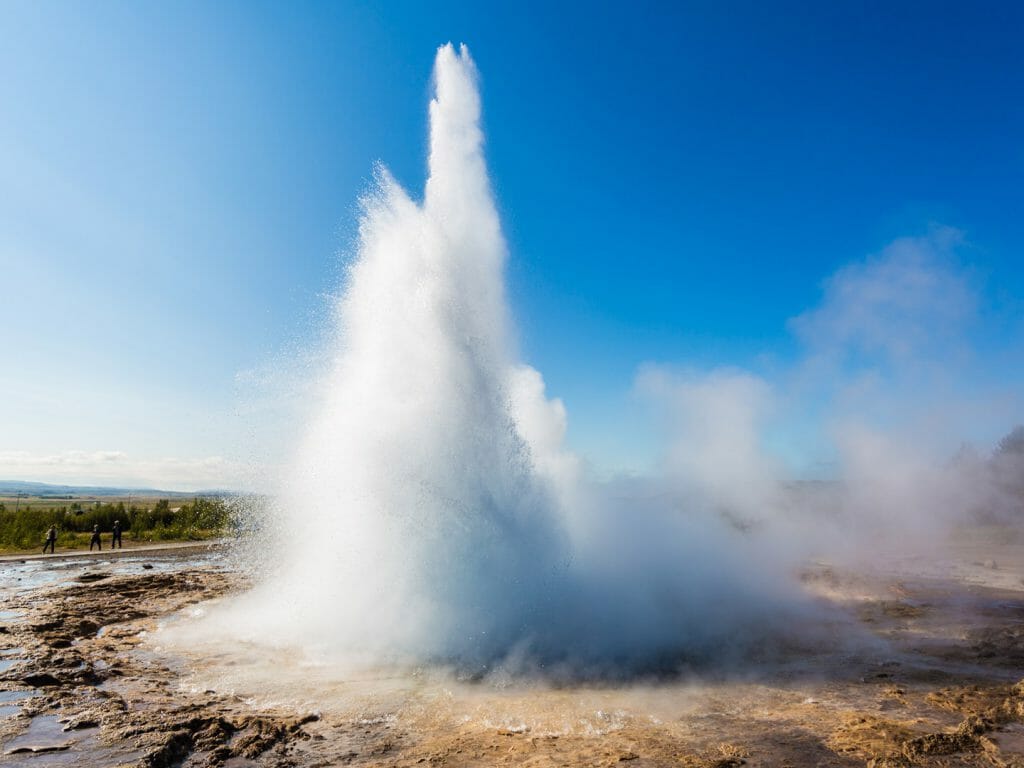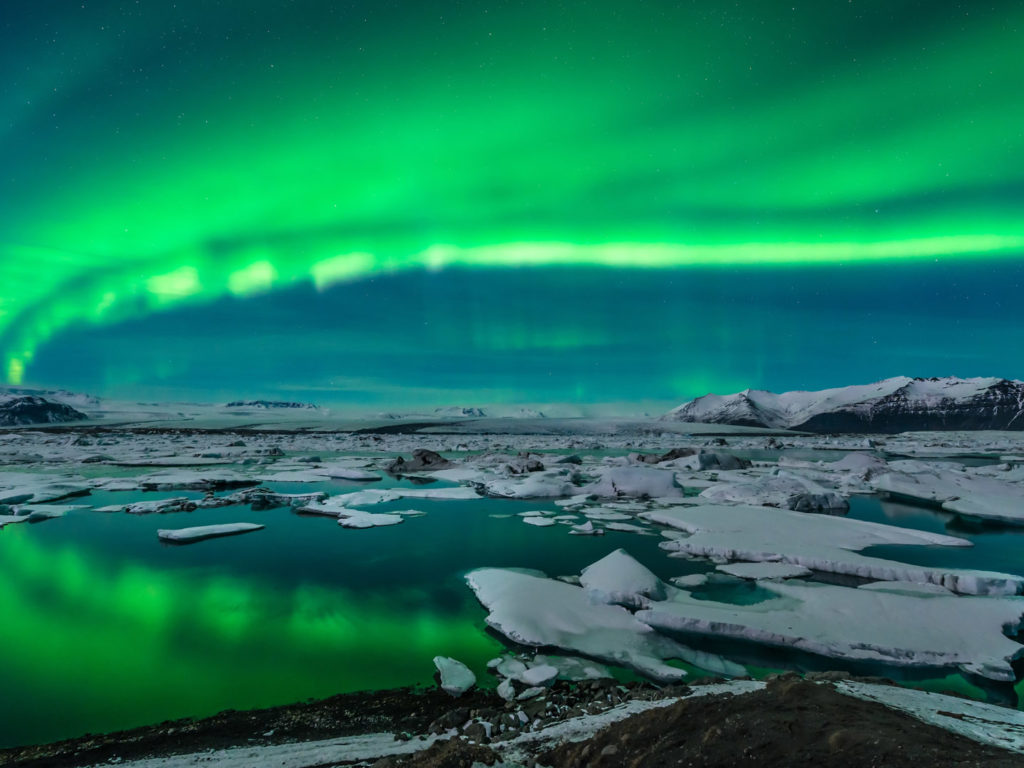I like to be in control and know what I am doing. It has served me well in my many travels around the world yet on arrival in Iceland I was denied this basic tenet. I found it difficult to let go. Well, at first, for I quickly realised that I was in more than capable hands.
The gleaming motor yacht awaiting us at Reykjavik harbour was testament of the calibre and class of the hands in which I had blindly put my faith. As we slipped our moorings and powered out in the harbour I was handed a chilled glass of Chablis and given a selection of mouth-watering nibbles that further emphasised the taste and tenor of my hosts. This was an outfit that more than understood exclusivity.
After a short cruise, that hinted beautifully at the opportunities of whale watching given more time, we disembarked at the private island of …….to be met by our next mode of transport, a helicopter. To say that Iceland is a spectacularly beautiful island is bordering on understatement. So varied and extreme is its scenery that there are many ways from which to enjoy it, nevertheless, helicopter has to be paramount. It was invigorating, exhilarating to fly in a helicopter but to do so over such dramatic scenery was a sheer delight. To fly over the tear in the crust that separates the American tectonic plate from the European tectonic plate was very special.
We landed in the central highlands and were taken to a most unusual house. It is not fair for me to say much about it but it is not for everyone.
From there we ticked off some of the main highlights of Iceland. I sound casual and dismissive about them but they are far from everyday phenomenon. I suppose that my lack of enthusiasm was clouded by the weather and for the first time of the day we had to share the sights with other tourists. When I say share I am only talking about a handful of tourists and none of the trappings of tourism that so pollute other sights around the world.
The day ended with a most relaxing spa session at the Blue Lagoon.
Yesterday had ended with arguably Iceland’s most visited site; today was all about a region the Central Highlands – where few dare to tread. When I say tread I am not referring to walking but rather the size of the tyres on the vehicle which pulled up outside our boutique hotel. My initial response was how ridiculous but hours later I was more than appreciative of their size as they had
Disengagement is the art of enjoying Iceland.
It is a harsh and difficult country, the only natural inhabitant of this incredible island is the Arctic fox.
Understanding of nature, the weather and elements is part of the national psyche. This is a country in which they say that if you don’t like the weather wait five minutes and it will change. One has to understand that you do not visit Iceland for the weather, in fact the opposite, the weather is not great yet this in it very self brings opportunities. Not necessarily for the better but it will be different. An umbrella is seen as being an affront to their make up.
Here Vulcanology is not the preserve of universities but forms part of the primary school curriculum. This is a country which has the largest glacier in Europe, a glacier that is the size of Denmark.
The road twists and turns taking the path of least resistance with each twist a new and equally dramatic scene – this is a photographer’s paradise, a geographic smorgasbord that
Rendered speechless by the extravagant scenery. Below Hevla the volcanic aftermath a black, desolate but weirdly beautiful reminder of the regularity – every ten years, which in the timeframe of geology is impressive t say the least –
Humans have an apologetic role and two-thirds of them have retreated to Reykjavik
“I’m always surprised by how many people have been to the moon,” remarked my laid back and dry guide, Anton. I laughed with him but then I tried to think of how else to describe this most unusual landscape. It is so different and so surreal that it is not surprising that most of us revert to the outlandish, have to describe it as being something not of this earth.
Icelandic humour is dry, ironic and playful – I like it – and perhaps summed up by a joke Anton told. It was of an Icelandic farmer visiting a farmer in Texas. True to type the Texan farmer was boasting of the size of his farm and that in one day it would not be possible to drive the whole extent of his farm. The Icelandic farmer retorts, “Yes, I had a car like that once.”
Famed for its women, strong men and hard drinking – a dangerous cocktail – there is much more to this magical island than stereotypes. Yes I was impressed by the sheer natural beauty of the country but what really impressed me was the insightful and interesting service and guidance that we received throughout.
This intriguing land of geysers and volcanoes, which has also carved a reputation for chic bars and cutting-edge cuisine, is now at its most affordable. The collapse of the Icelandic kroner make it a great time to discover Reykjavik, the most northerly capital in the world, as well as the natural wonders of this charismatic island.
At first glance, Reykjavik is quaint and quirky – you would not associate the motley collection of gaily-coloured tin-roofed buildings with a capital city. It is laid-back and welcoming, not dissimilar to its people who are more akin to Brits than Scandinavians. The Vikings scooped up Celtic women en route to Iceland and their descendants are, as a result, more ironic and less inscrutable than other Nordics.
But like its people there is more to Reykjavik than meets the eye. In terms of accommodation, the Hotel Borg is an art deco jewel with elegance and service. For something a little more hip, try the ultra contemporary 101 Hotel, my base for my stay.
In spite of whale and whale and puffin being a menu staple, seriously good food is on offer. Take for example, the Seafood Cellar, one of the many fusion restaurants in the city and reputedly one of the finest restaurants in Scandinavia, which specialises in an idiosyncratic take on all things fishy.
Reykjavik is relatively straightforward, the interior less so, especially given that I wanted to avoid the coach tours, wanted something a little more private. The gleaming motor yacht awaiting me at Reykjavik harbour dispelled any doubts. As we slipped our moorings, I was handed a chilled glass of Chablis and given a selection of mouth-watering nibbles that further emphasised the taste and tenor of our team on the ground. This was an outfit that more than understood exclusivity.
After a short cruise that hinted at the opportunities of whale watching, we disembarked to be met by our next mode of transport, a helicopter. To say that Iceland is spectacularly beautiful is bordering on understatement. So varied and extreme is its scenery that there are many ways from which to enjoy it, nevertheless, helicopter has to be paramount. It was invigorating, exhilarating to fly in a helicopter but to do so over such dramatic scenery was a sheer delight, not least over the tear in the crust that separates the American from the European tectonic plate. (For the more adventurous you can actually dive between the plates at Silfra Thignvelir.)
We arrived at Geyser to see Mother Earth in full action, her heart pulsating, her chambers rumbling below. In yellow ochre pools of steaming water, the earth breathes slowly before exploding high into the sky. Nearby the waterfall at Gullfoss is impressive, the ice blue glacial waters thundering over the black rocks below.
From arguably Iceland’s most visited site – the Geyser – to a region where few dare to tread, the Central Highlands. When I say tread I am not referring to walking but rather the size of the tyres on the Super Jeep which pulled up outside the 101 hotel. My initial response was how ridiculous but hours later I was more than appreciative of their size as they had allowed us to access some truly magnificent scenery that rendered me speechless.
Everywhere you looked was a geographic smorgasbord of contrasting colours. An artist’s mixing pallet with the added effect of cauldrons of steam seeping from the crevasses. Ribbons of lime green moss streamed down the volcano sides as pockets of white glaciers nestled between the black lava.
We continued into the interior to Hekla, Iceland’s most active volcano. The volcanic aftermath was black and desolate but a weirdly beautiful reminder of the regularity – every ten years, which in the timeframe of geology is impressive – with which the volcano erupts.
Their banks may have hammered our pension funds, but Icelanders are giving something back this year — at least to visitors. This fascinating land of geysers and volcanoes, which has also carved an urban reputation for hot clubs, cool bars and cutting-edge design is now at its most affordable in a decade.
Devaluation — theirs — plus low-cost flights make this a great time to discover Reykjavik, the most northerly capital in the world, as well as the natural wonders of the nearby Golden Triangle.
Not that you would identify this motley collection of gaily-coloured tin-roofed buildings as a capital at first sight.
Reykjavik today is almost as tiny, laid-back and villagey as when I was sent to knock on the door of the parliament 20-odd years ago and ask if the president could come out for a chat.
She did, and that ad hoc newspaper interview was a salutary introduction to the accessibility and friendliness of these people who are more akin to Brits than Scandinavians.
The Vikings who arrived 1,000 years ago scooped up Celtic women on their way west and their descendants are, as a result, warmer, funnier and less inscrutable than other Nordics.
Their wild and woolly heritage — which Icelanders have only recently begun exploiting — is quite fascinating and worth checking out while in the capital.
Lifelike figures star in audio-guided vignettes of how this young civilisation was formed at the Saga Museum in Perlan, a striking exhibition space at the top of the town.
Above the museum is a revolving restaurant aimed at the fine dining crowd, while the casual café has a scenic terrace which offers fabulous city views.
The bright buildings and coloured rooftops of Iceland’s capital Reykjavik make it resemble a town built from the Lego bricks made by the Danes, who once ruled the island
In the heart of town, an old Viking long-house was recently discovered during excavations, and a picture of life circa 1,000 has been engagingly mounted on the site at the Reykjavik Settlement Exhibition.
But having explored the past, there is much to be seen during a weekend break of what today’s Iceland has to offer the tourist.
Fashion and design shopping tempt at every turn, notably on the main shopping street Laugavegur and the more exclusive Skolavordurstigur which leads up to Hallgrimskirkja, the distinctive, tall, white modernist church which is the city’s main landmark. Check out Spaksmannsspyarir, Steinunn and the more affordable E-Label on Laugavegur and Galleri 21 on the stroll up to the church.
Down by the harbour, Gaga has wonderful one-off garments and some enviable sweater pins. In the unpromisingly-named Iceland Gift Shop nearby, M-Design’s wonderful long Icelandic wool cardigans are on sale at the best price in town. It’s worth noting that 15 percent VAT refunds on purchases over about £20 are available instantly at the tourist office.
Tempting cafés everywhere provide an opportunity to rest the feet, and seriously good food is also on offer. Sjavarkjallarinn, aka the Seafood Cellar, beneath the tourist office is one of the finest restaurants in Scandinavia, dispensing a quirky modern take on all things fishy, including sushi as you’ve never experienced it before.
Less pricey is the Fish Company across the road, a good place to try the creamy seafood soup which is a Reykjavik speciality, though not every version is for the observant.
It would be hard to find a more central and comfy perch than the Hotel Borg, an art deco jewel with astonishingly good service and an excellent buffet breakfast served with elegance. There is also a pukka design hotel in town, The 101, a little more hip and cutting-edged.
Don’t leave town without spending a couple of hours at the Blue Lagoon, the largest and most luxurious of Iceland’s many natural hot springs. The Lagoon also fields a full-service spa, an enticing shop and formal restaurant, since many visitors linger into the evening. The Lagoon is more than halfway to the airport, and many bus companies offer the chance to make a visit the last — or even first — stop in Reykjavik.
It is really worth spending an extra day or two to get a glimpse of Iceland’s natural glories, and the most popular trip is the so-called Golden Triangle. This takes in Geysir, named for the eponymous spouting hot spring, Gullfoss, a thunderingly magnificent waterfall, and the breathtakingly beautiful Thingvellir National Park.
The park — the site of Iceland’s first parliament, formed by the clan chieftains who instigated law-making gatherings here in the 10th century — is integral to Iceland’s history. But what attracts visitors is the thrilling geography: the massive rift valley marking the point where North America separated from Europe, and views of the distant brooding Skjaldbreidur volcano.
After marvelling at the shifting earth, the smouldering lava cone, the bubbling hot springs and the rushing water — a microcosm of the wonders to be found all over Iceland — wind down by getting up close and personal with another of the country’s magnificent legacies — the beautiful horses which have stayed true to their breed since being introduced 1,000 years ago.
Although they can be seen roaming freely in the countryside, the family horse display near Geysir allows visitors to learn about their special attributes as they’re put through their paces in an arena, and then after, to pet their beautiful noses in the stables.
Coach tours covering all these high points in a single day are available at the drop of a hat, but it’s worth driving yourself, or taking a private guided tour, to get the most out of the experience and be able to spend as long as you want in each place.
Jon Baldur’s Isafold tours in rugged, four-wheel drive vehicles offer the chance to get off-road in this magnificent terrain and go for some extra thrills. Fording rivers and driving on the glaciers of Iceland’s south coast are both on offer.








